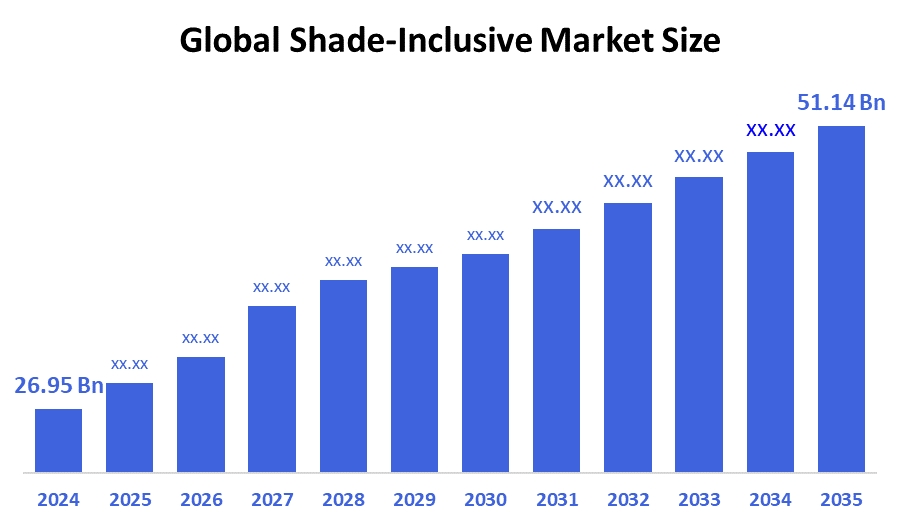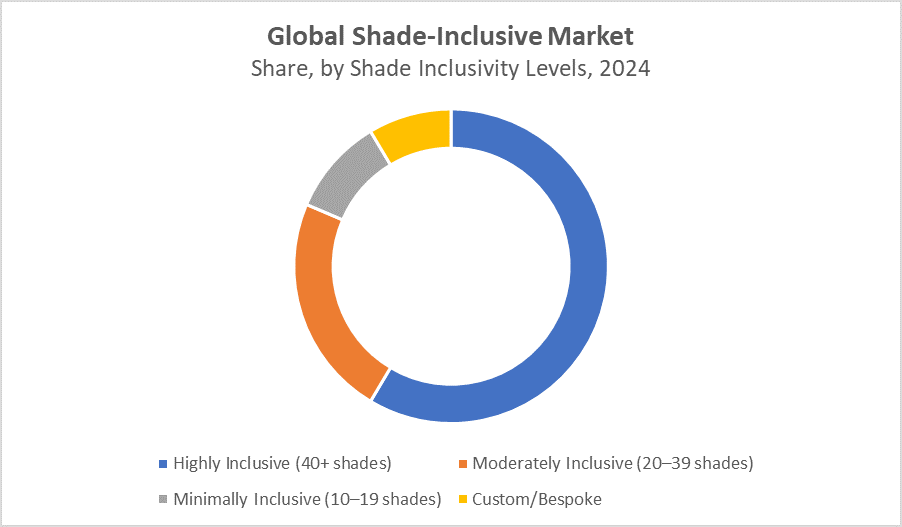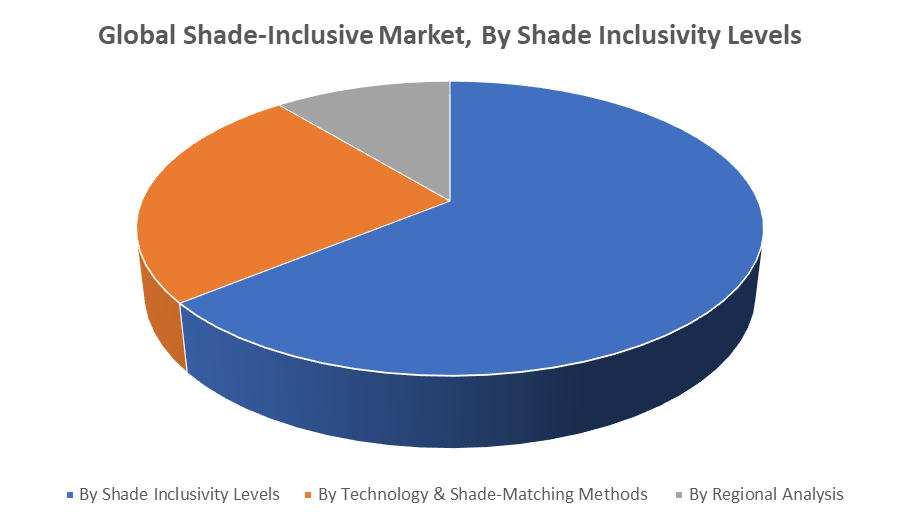Global Shade-Inclusive Market
Global Shade-Inclusive Market Size, Share, and COVID-19 Impact Analysis, Impact of Tariff and Trade War Analysis, By Shade Inclusivity Levels (Highly Inclusive (40+ shades), Moderately Inclusive (20?39 shades), Minimally Inclusive (10?19 shades), and Custom/Bespoke), By Technology & Shade-Matching Methods (AI/AR-Based Matching, Device-Assisted Matching, Algorithmic Online Matching, Professional Matching (Expert consultations), and Accessible Matching), and By Region (North America, Europe, Asia-Pacific, Latin America, Middle East, and Africa), Analysis and Forecast 2025 - 2035
Report Overview
Table of Contents
Shade-Inclusive Market Summary, Size & Emerging Trends
According to Spherical Insights, the Global Shade-Inclusive Market Size is expected to grow from USD 26.95 Billion in 2024 to USD 51.14 Billion by 2035, at a CAGR of 6% during the forecast period 2025-2035. The growth of the shade-inclusive market is driven by increasing consumer demand for diversity and representation in beauty and fashion products.

Key Market Insights
- Asia-Pacific is expected to account for the largest share in the shade-inclusive market during the forecast period.
- In terms of shade inclusivity levels, the highly inclusive (40+ shades) segment accounted for the largest market share of the global shade-inclusive market during the forecast period
- In terms of technology & shade-matching methods, the AI/AR-based matching segment accounted for the major revenue share of the global shade-inclusive market during the forecast period
Global Market Forecast and Revenue Outlook
- 2024 Market Size: USD 26.95 Billion
- 2035 Projected Market Size: USD 51.14 Billion
- CAGR (2025-2035): 6%
- Asia-Pacific: Largest market in 2024
- North America: Fastest growing market
Shade-Inclusive Market
The shade-inclusive market focuses on providing products that cater to a wide spectrum of skin tones, primarily in cosmetics, fashion, and personal care. This market promotes diversity and inclusivity by offering a broad range of shades, ensuring that people of all skin colors find suitable options. Governments globally support this movement through initiatives that encourage equality and representation, such as diversity guidelines in advertising and funding programs for minority-owned businesses. These efforts aim to foster inclusivity and combat historical underrepresentation. The growing consumer demand for personalized and authentic products has accelerated the market’s expansion, pushing brands to innovate and diversify their offerings. Overall, the shade-inclusive market reflects a broader societal commitment to embracing diversity, promoting fairness, and meeting the needs of all consumers, making it a significant driver of positive social and economic transformation.
Shade-Inclusive Market Trends
- Brands are increasing their product shade offerings, especially in makeup and skincare, to better represent diverse skin tones. This ensures customers from all backgrounds find suitable matches, promoting inclusivity and customer satisfaction.
- Companies are using AI and augmented reality (AR) tools to help consumers find their perfect shade. Virtual try-ons and personalized recommendations enhance the shopping experience and reduce product returns.
- Marketing campaigns now feature diverse models and influencers from various ethnicities and skin tones. This authentic representation strengthens brand loyalty and resonates with a wider audience seeking genuine inclusivity.
Shade-Inclusive Market Dynamics
Driving Factors: Technological advancements like AI-powered shade matching improve personalized shopping experiences
The growth of the shade-inclusive market is driven by increasing consumer demand for diversity and representation in beauty and fashion products. Rising awareness about inclusivity encourages brands to expand their shade ranges, attracting a broader customer base. Technological advancements like AI-powered shade matching improve personalized shopping experiences, boosting sales. Social media amplifies the voices of underrepresented communities, influencing brand transparency and product development. Additionally, government initiatives promoting equality and anti-discrimination create a supportive environment for inclusive products. Together, these factors foster market expansion by aligning with evolving consumer values and preferences toward acceptance and diversity.
Restrain Factors: Supply chain complexities in sourcing diverse raw materials may hinder scalability
Restraining factors in the shade-inclusive market include high production costs associated with developing and manufacturing a wide range of shades, which can limit accessibility for smaller brands. Inconsistent quality across different shades may also affect consumer trust. Additionally, some brands may face challenges in effectively marketing inclusive products without appearing insincere or opportunistic, risking backlash. Limited awareness in certain regions and cultural resistance to diversity initiatives can slow market adoption. Lastly, supply chain complexities in sourcing diverse raw materials may hinder scalability, restricting rapid expansion despite growing demand for shade-inclusive products.
Opportunity: Expanding product lines to cover a broader range of skin tones
The shade-inclusive market presents significant opportunities as consumers increasingly prioritize diversity and personalized experiences. Expanding product lines to cover a broader range of skin tones allows brands to tap into underserved markets, driving customer loyalty and higher sales. Technological innovations, such as AI-driven shade matching and virtual try-on tools, offer enhanced personalization, improving the shopping experience and reducing product returns. Collaborations with influencers and creators from diverse backgrounds can amplify brand authenticity and reach new audiences. Additionally, rising global awareness about social justice and equality creates a favorable environment for brands that champion inclusivity. Emerging markets with growing middle-class populations also present untapped potential. Overall, embracing shade inclusivity enables brands to differentiate themselves, build stronger connections with consumers, and foster long-term growth in an evolving marketplace.
Challenges: Cultural resistance in some regions
Challenges in the shade-inclusive market include the complexity and cost of developing extensive shade ranges, which can strain resources, especially for smaller brands. Ensuring consistent quality across all shades is difficult and crucial for consumer trust. Missteps in marketing inclusivity may lead to accusations of insincerity or tokenism. Additionally, cultural resistance in some regions slows acceptance. Supply chain difficulties in sourcing diverse ingredients and pigments further complicate production, limiting scalability despite rising demand for truly inclusive products.
Global Shade-Inclusive Market Ecosystem Analysis
The global shade-inclusive market is driven by growing consumer demand for diversity and authentic representation, especially among younger generations. Leading brands like Fenty Beauty and L’Oréal are expanding shade ranges and using AI for personalized shade matching. Inclusive marketing featuring diverse models strengthens brand loyalty. However, challenges such as supply chain complexities and ensuring genuine inclusivity remain. Supported by government initiatives and social awareness, the market is projected to grow significantly, reflecting a broader cultural shift toward equity and personalized beauty experiences worldwide.
Global Shade-Inclusive Market, By Shade Inclusivity Levels
The highly inclusive (40+ shades) segment accounted for the largest market share of the global shade-inclusive market during the forecast period. This extensive shade range meets the diverse needs of consumers, driving strong demand and brand loyalty. Pioneered by brands like Fenty Beauty, this approach has set new industry standards, encouraging more companies to expand their shade offerings to capture a wider audience and promote true inclusivity in beauty and personal care products.

The moderately inclusive (20–39 shades) segment accounted for a significant revenue share of the global shade-inclusive market during the forecast period. This range balances variety and accessibility, appealing to a broad customer base seeking diverse but manageable shade options. Many established brands adopt this approach to cater to diverse skin tones while optimizing production costs, contributing notably to overall market growth and inclusivity efforts.
Global Shade-Inclusive Market, By Technology & Shade-Matching Methods
The AI/AR-based matching segment accounted for the major revenue share of the global shade-inclusive market during the forecast period, with a share value of 45%
The algorithmic online matching segment accounted for a significant market share of the global shade-inclusive market during the forecast period, with a share value of 25%.
Asia-Pacific is expected to account for the largest share in the shade-inclusive market during the forecast period, with a share of 42%. Advanced technologies like artificial intelligence and augmented reality enhance personalized shade matching, improving customer satisfaction and reducing product returns. These innovations enable consumers to find their perfect match virtually, driving adoption and boosting sales across beauty and personal care brands focused on inclusivity.
India is projected to be the fastest-growing economy in the Asia-Pacific region during the forecast period, with a growth rate of 6.7%. With more people earning higher incomes, consumers have greater purchasing power. This leads to increased demand for a variety of products, including beauty and personal care items that cater to different skin tones. Because India is so diverse in terms of skin color, the shade-inclusive market has huge potential there. Brands that offer a wide range of shades and personalized products can tap into this growing market, making India a strategic focus for future expansion.
North America is projected to be the fastest-growing region in the shade-inclusive market during the forecast period, with a market share of 28%, driven by increasing consumer awareness around diversity and inclusivity, coupled with strong demand for personalized beauty products. The region's well-established beauty industry, supported by technological innovations like AI-based shade matching and inclusive marketing campaigns, is fueling market expansion. Additionally, progressive social movements and supportive government policies encourage brands to develop broader shade ranges, making North America a key hub for shade-inclusive product growth.
Mexico is projected to be the fastest-growing economy in North America during the forecast period. This economic growth is expected to boost consumer spending power, increasing demand for diverse and shade-inclusive beauty and personal care products. As awareness around inclusivity rises, Mexico presents a significant opportunity for brands to expand their shade ranges and cater to its diverse population, making it a key market within the North American shade-inclusive landscape.
WORLDWIDE TOP KEY PLAYERS IN THE SHADE-INCLUSIVE MARKET INCLUDE
- Fenty Beauty
- Pat McGrath Labs
- M.A.C Cosmetics
- Haus Labs by Lady Gaga
- NARS
- Huda Beauty
- Tarte Cosmetics
- L'Oréal Paris
- Maybelline New York
- CoverGirl
- Others
Product Launches in Shade-Inclusive Market
- In August 2025, Charlotte Tilbury launched the reformulated Airbrush Flawless Foundation. This new formula offers a full-coverage, 3D matte finish designed to blur imperfections and provide a natural-looking complexion. It is available in 44 shades, catering to a wide range of skin tones and undertones. The foundation is praised for its lightweight texture and long-lasting wear, resisting sweat, humidity, and transfer. Users have noted its adaptability to different skin types, providing a smooth and even finish.
Market Segment
This study forecasts revenue at global, regional, and country levels from 2020 to 2035. Decision Advisors has segmented the shade-inclusive market based on the below-mentioned segments:

Global Shade-Inclusive Market, By Shade Inclusivity Levels
- Highly Inclusive (40+ shades)
- Moderately Inclusive (20–39 shades)
- Minimally Inclusive (10–19 shades)
- Custom/Bespoke
Global Shade-Inclusive Market, By Technology & Shade-Matching Methods
- AI/AR-Based Matching
- Device-Assisted Matching
- Algorithmic Online Matching
- Professional Matching (Expert consultations)
- Accessible Matching
Global Shade-Inclusive Market, By Regional Analysis
- North America
- US
- Canada
- Mexico
- Europe
- Germany
- UK
- France
- Italy
- Spain
- Russia
- Rest of Europe
- Asia Pacific
- China
- Japan
- India
- South Korea
- Australia
- Rest of Asia Pacific
- South America
- Brazil
- Argentina
- Rest of South America
- Middle East & Africa
- UAE
- Saudi Arabia
- Qatar
- South Africa
- Rest of the Middle East & Africa
FAQs
Q: What are the key drivers of growth in the Shade-Inclusive Market?
A: Increasing consumer demand for diversity and representation, technological advancements like AI-powered shade matching, social media influence, and supportive government initiatives drive market growth.
Q: What challenges are faced by the Shade-Inclusive Market?
A: Challenges include supply chain complexities, high production costs, inconsistent quality, cultural resistance in some regions, and the risk of insincere marketing.
Q: Which countries are highlighted as fast-growing economies in the Shade-Inclusive Market?
A: India in Asia-Pacific and Mexico in North America are projected to be the fastest-growing economies during the forecast period.
Q: Who are the leading companies operating in the Global Shade-Inclusive Market?
A: Key players include Fenty Beauty, Pat McGrath Labs, M.A.C Cosmetics, Haus Labs by Lady Gaga, NARS, Huda Beauty, Tarte Cosmetics, L'Oréal Paris, Maybelline New York, and CoverGirl.
Q: What are the latest trends in the Shade-Inclusive Market?
A: Trends include expansion of shade ranges, AI and AR-powered virtual try-ons, and marketing campaigns featuring diverse models to promote authentic representation.
Q: What opportunities exist in the Shade-Inclusive Market?
A: Opportunities include expanding product lines for broader skin tone coverage, leveraging AI for personalized shopping experiences, collaborations with diverse influencers, and tapping into emerging markets.
Q: Can you provide an example of a recent product launch in the Shade-Inclusive Market?
A: In August 2025, Charlotte Tilbury launched the reformulated Airbrush Flawless Foundation available in 44 shades, praised for its lightweight texture and long-lasting wear.
Q: How do AI and AR technologies impact the Shade-Inclusive Market?
A: AI and AR technologies improve personalized shade matching, enhance customer satisfaction, reduce product returns, and drive adoption of inclusive beauty products.
Check Licence
Choose the plan that fits you best: Single User, Multi-User, or Enterprise solutions tailored for your needs.
We Have You Covered
- 24/7 Analyst Support
- Clients Across the Globe
- Tailored Insights
- Technology Tracking
- Competitive Intelligence
- Custom Research
- Syndicated Market Studies
- Market Overview
- Market Segmentation
- Growth Drivers
- Market Opportunities
- Regulatory Insights
- Innovation & Sustainability
Report Details
| Pages | 250 |
| Delivery | PDF & Excel via Email |
| Language | English |
| Release | Sep 2025 |
| Access | Download from this page |
